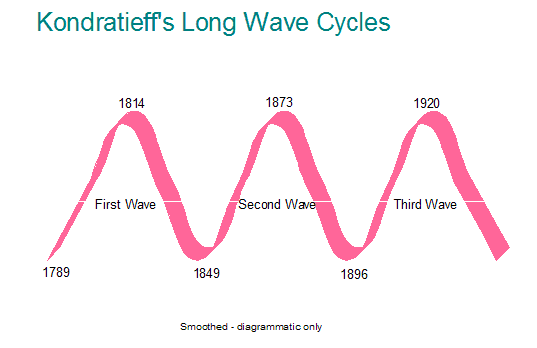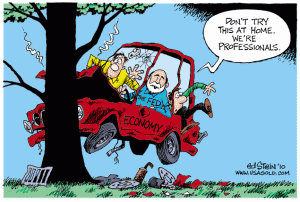
“LongWave Basics
by Bryan Kavanagh
22 December 1999 11:20 UTC
>At 06:06 AM 12/21/99 -0700, Tom Drake wrote:
>
>> I wrote
>> 1) Demographics – no.
>> 2) Collective memory – no.
>> 3) Master clock – no.
>> 4) Rent-seeking as a result of taxes – yes.
>>
>> If 4 remains obscure, then 1, 2, & 3 will forever remain as candidates.
>> When we are able humbly to acknowledge that we are indeed
>> inextricably fused with air, and are every bit as reliant
>> upon other natural resources, we will begin to gain some insight into
>> the utter economic absurdity, the devastating wastage of human potential
>> of taxing wealth-creation. If ever we do lift this veil, then the
>> naturalness of a community charge on the use of natural resources for
>> necessary public service and infrastructure will hit us in a blinding
>> flash. Then and only then, will the Longwaves list be redundant.
>>
>> – Bryan Kavanagh
>>
>————————————————————————–
>Bryan,
>
>I have read your site and followed your posts for over three years.
>Your work on real estate cycles has been very interesting to me
>and has helped my own understanding of the Long Wave.
>
>But I do not understand *HOW* the “economic absurdity…. of
>taxing wealth creation” rather than taxing the “use of natural
>resources” is a cause of the LongWave itself.
>
>Could you go into this in greater detail, and since this is a more
>Long Wave-related discussion than what goes on at the site itself
>in the past year, perhaps it should go there?
>
>Regards,
>
>Tom Drake
>
>Tenorio Research
>editor@TenorioResearch.itgo.com
OK, Tom. On the assumption that people here on the Longwaves list may be interested, I’ll attempt the task.
DEMOGRAPHICS: Our neo-Malthusian friends would have it that population increase leads to shortages. What, then, of the benefits of specialisation and mass production? At what point exactly do benefits attaching to these commence to reverse upon themselves? IMO, of itself, demographics has little or no influence on the K-wave.
COLLECTIVE MEMORY may seem appealing, too, but what are we really saying here? What *is* it precisely that becomes obscure to the collective memory? Excessive debt? Financial collapse? Recession? Depression? Really?
The MASTER CLOCK theory will also have its adherents, especially on a list such as the Kondratieff Wave.
But none of these theories describes the economic fundamentals of what *causes* the economy to derail.
The birds continue to eke out a chirpy living; so the question becomes what are *we* doing wrong?
Clearly, the problem is the extraordinary knot which repetitively develops in our distributional system.
Do we not we hear much about the community decrying the paradoxically widening gap between the rich and the poor in this ‘healthy, booming economy’? What is the process by which this gap widens – because, eventually, if Joe Sixpack no longer has a dollar in his pocket and can’t service his debts: the wheels of the economy must start to fall off.
The wealthy cannot make the economy go round by themselves – they need Joe. They won’t admit it, but he is integral. Many on the Longwaves list hold this process began to unfold in the early seventies. I believe its pace quickened discernibly in 1990/’91, after the collapse of western commercial real estate markets in 1989, and the process will gradually roll from denouement to conclusion.
[Segue] Why do people *have* to work for others? What if people all had the opportunity to work for themselves? Under the latter scenario, owners of capital would have to bid up wages in order to attract workers away from their own pursuits. This would never do: so those who run the show have to think up a ruse to keep people in their place. A new form of slavery, perhaps?
This was no better exemplified than in the case of the founding of the colony at South Australia. Wages and living conditions are notoriously better in a new colony, such as also the US once was. However, a not-too-nice chap by the name of Edward Gibbon Wakefield, who wrote a book called “England and America”, thought his class still needed cheap labour in these circumstances. Although his family was well off, he had abducted two heiresses and spent time in jail for kidnapping the third with intent to marry. He had been doing some thinking whilst interned in Newgate prison.
Wakefield thought there was a way by which you could found a colony which was not based upon cheap *convict* labour, as Sydney town had been. Why not simply release land to the colonists “at sufficient price” that only the wealthy will be able to afford their ‘town block’ and rural broadacre parcel – so others will have to work for years before they are able to afford a deposit, much less pay it off. [Enter the mortgage, ‘the grip of death’.]
There’s your cheap, subdued (cowed?) labour force.
Wakefield touted his theory, ‘The Wakefield Plan’, for colonising South Australia, New Zealand & Canada. The wealthy lapped it up. The Church also thought it had great merit. It would stop people from seeking to raise themselves beyond their proper station in life.
[Segue again: to a pier in Auckland, New Zealand, 1890.] Two men, one the tough former explorer Sir George Grey, governor of New Zealand, and former governor of the colony of South Australia, where he had seen Wakefield’s plan break out into a depression as the investors’ land bubble burst. Wakefield’s ideas were in opposition to Grey’s duty to society and compassion for working people . The other man: an American by the name Henry George. They shook hands, meeting only briefly, because George’s ship was quickly bound for Australia.
I fancy the discussion went something like this:
“That fellow Wakefield is now in New Zealand with his Plan, I see, Sir George.”
“Yes, Henry. He’s a friend to the rich, and a bane to all others!”
“Deucedly using my P – R = W + I to advantage the already-privileged, too!”
“Just so, Henry: just so. He has always been one with an eye for the main chance at society’s expense.”
[Cutting to the chase]
As times recover after the depression, and people get back to work, it is often not only employment that begins to grow again. Land price also gets up off the floor where it needed to remain. As land prices are permitted to resurrect with prosperity, so do mortgage commitments; so does the taxation of labour and capital.
Taxes cascade throughout the economy into every nook and cranny, doubling the prices of goods and services – as distinct from a community charge on resource rents which cannot be passed on in costs and prices.
The twin pathologies—-taxes and land prices—-pick up … mortgages growing, growing….until massive debt and speculative rent-seeking by the wealthy (and those who aspire to be like them) starts to choke off real wealth production….. once again.
Another depression.
Innovation; demographics; collective memory; master clock? Nah. Taxes, land prices, debt and rent-seeking, rotating in hopelessly repetitive cycles of boom and bust.
A community charge on land and other natural resource rents would break this cycle, IMHO.
A far better case is impeccably put at http://www.henrygeorge.org/chp1.htm
– Bryan Kavanagh“












